How to remove HackBoss stealer malware from the operating system?
TrojanAlso Known As: HackBoss malware
Get free scan and check if your device is infected.
Remove it nowTo use full-featured product, you have to purchase a license for Combo Cleaner. Seven days free trial available. Combo Cleaner is owned and operated by RCS LT, the parent company of PCRisk.com.
What kind of malware is the HackBoss stealer?
HackBoss is a piece of malicious software classified as a stealer. It operates by redirecting outgoing cryptocurrency transactions by replacing recipients' cryptowallet addresses with its own. This malware has netted significant gain in Bitcoin, Ethereum, Monero, Litecoin, and Dogecoin cryptocurrencies.
The HackBoss stealer is active worldwide, particularly in the United States, Nigeria, and Russia. Its main proliferation method is via various fake hacking, "cracking", password brute-forcing tools, and other malicious applications - supposedly designed to target cryptocurrency-related, banking, social networking/media, and dating accounts.
The fake apps themselves are primarily distributed through the Hack Boss Telegram channel; however, they have been observed being spread through a variety of blogs, forums, and YouTube channels.
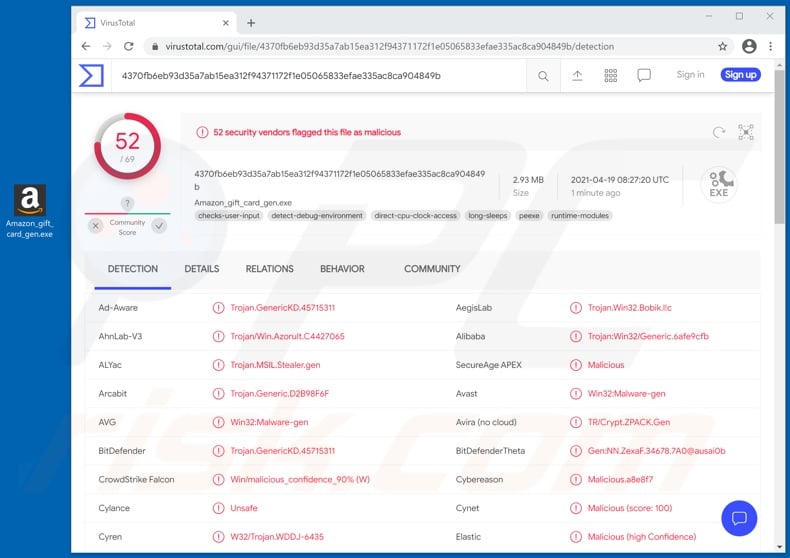
HackBoss stealer overview
The scam apps are downloaded in archives (usually in the ZIP format), which when unpacked - contain an executable file. Upon this file's execution, an interface of the fake application is opened.
These apps have been noted wearing dozens of different disguises, such as: hacking tools for cryptocurrency wallets, "cracks" for digital wallet private keys (which grant users ownership of the funds on a given cryptowallet address), fake cryptocurrency senders (used to make bogus transactions when paying in said currency), brute-force tools (designed to generate numerous combinations in the hopes of finding correct passwords or passkeys) of various accounts (e.g., eBay, Facebook, etc.), gift card code generators (e.g., Amazon, etc.), and many others.
However, none of these applications operate as promised. Instead, when users click any of the buttons presented in their interfaces - HackBoss stealer's infection chain is initiated. The malicious program sets up a registry key to be run at startup and/or adds a scheduled task, which is to be repeated every minute.
This is the method HackBoss uses to ensure persistence. Therefore, even if its process is terminated using the Windows Task Manager, the stealer automatically runs after the system is started/booted. Alternatively, the malware can be run again per the next scheduled task, which repeat minutely.
The goal of the HackBoss stealer is to replace cryptowallet addresses copied into the clipboard with those belonging to the cyber criminals - when victims are making a cryptocurrency transaction. Thereby, as the intended recipients' address is pasted - the stealer actually pastes one of its own.
Therefore, rather than arrive into the chosen cryptowallet - the transaction is redirected to the criminals' wallet. To summarize, HackBoss infections can result in financial losses and other serious problems.
If it is known or suspected that the HackBoss stealer (or other malware) has already infected the system - an anti-virus must be used to remove it immediately.
| Name | HackBoss malware |
| Threat Type | Trojan, password-stealing virus, banking malware, spyware. |
| Detection Names | Avast (Win32:Malware-gen), BitDefender (Trojan.GenericKD.45715311), ESET-NOD32 (A Variant Of Generik.LLRXDEF), Kaspersky (HEUR:Trojan-Spy.Win32.Bobik.gen), Microsoft (Trojan:Win32/Azorult!ml), Full List Of Detections (VirusTotal) |
| Symptoms | Trojans are designed to stealthily infiltrate the victim's computer and remain silent, and thus no particular symptoms are clearly visible on an infected machine. |
| Distribution methods | Infected email attachments, malicious online advertisements, social engineering, software 'cracks'. |
| Damage | Stolen passwords and banking information, identity theft, the victim's computer added to a botnet. |
| Malware Removal (Windows) |
To eliminate possible malware infections, scan your computer with legitimate antivirus software. Our security researchers recommend using Combo Cleaner. Download Combo CleanerTo use full-featured product, you have to purchase a license for Combo Cleaner. 7 days free trial available. Combo Cleaner is owned and operated by RCS LT, the parent company of PCRisk.com. |
Similar malware
Ares, Spectre, Xenon, and Sorano Bot are some examples of malicious programs that target cryptocurrency. In general, malware can have a wide variety of heinous functionalities, and these functions can be in different combinations.
Common features include: download/installation of additional malware, data encryption and/or screen locking for ransom purposes (ransomware), enablement of remote access and control over the infected machine (RATs - Remote Access Trojans), exfiltration (download) of content stored on the compromised system, information extraction from browsers and other installed applications, recording of keystrokes and/or audio/video, use of system resources to mine cryptocurrency (cryptominers), and so on.
Regardless of how malicious software operates, its sole goal is to generate revenue for the cyber criminals using it. All malware infections are dangerous, and as such - they must be eliminated immediately upon detection.
How did HackBoss infiltrate my computer?
As previously mentioned, HackBoss trojan is spread via fake apps, allegedly aimed at "hacking", "cracking", "cheating", or otherwise abusing various accounts, platforms, and services.
The bogus applications don varied disguises - they are supposedly designed to target cryptocurrency wallets, social networking and social media accounts, e-commerce platforms, etc. These apps are endorsed through Telegram and YouTube channels, blogs, and forums.
This is relatively standard in malware proliferation as malicious programs are often presented as or bundled with ordinary software/media.
They are also commonly distributed via untrustworthy download channels, e.g., unofficial and free file-hosting (freeware) websites, Peer-to-Peer sharing networks (Torrent clients, eMule, Gnutella, etc.), and other third-party downloaders. Illegal software activation ("cracking") tools and fake updates are prime examples of malware-spreading content, typically obtained from such dubious download sources.
"Cracks" can infect systems instead of activating licensed products. Illegitimate updaters cause infections by exploiting weaknesses of outdated programs and/or installing malicious software rather than the updates. Another popular malware-proliferation technique is distribution via spam campaigns.
This term defines a large-scale operation during which deceptive emails are sent by the thousand. The letters usually appear "official", "important", "urgent", and similar; they may even be disguised as mail from genuine institutions, authorities, organizations, companies, service providers, and other entities.
The scam emails have infectious files attached to and/or linked inside them. Virulent files can be in a variety of formats, e.g., archives (ZIP, RAR, etc.), executables (.exe, .run, etc.), PDF and Microsoft Office documents, JavaScript, and so forth.
When these files are opened - the infection process (i.e., download/installation of malicious programs) is triggered.
How to avoid installation of malware?
It is important to always research software before download/installation and/or purchase. It is strongly recommended to download only from official and verified sources. Additionally, all programs must be activated and updated with tools/functions provided by legitimate developers.
To avoid infecting the device via spam mail, it is advised against opening suspicious and irrelevant emails - especially any attachments or links found in them. It is crucial to have a reputable anti-virus/anti-spyware suite installed and updated.
Furthermore, this software has to be used to perform regular system scans and remove detected threats and issues. If you believe that your computer is already infected, we recommend running a scan with Combo Cleaner Antivirus for Windows to automatically eliminate infiltrated malware.
Some of the fake applications used to proliferate HackBoss stealer:
Instant automatic malware removal:
Manual threat removal might be a lengthy and complicated process that requires advanced IT skills. Combo Cleaner is a professional automatic malware removal tool that is recommended to get rid of malware. Download it by clicking the button below:
DOWNLOAD Combo CleanerBy downloading any software listed on this website you agree to our Privacy Policy and Terms of Use. To use full-featured product, you have to purchase a license for Combo Cleaner. 7 days free trial available. Combo Cleaner is owned and operated by RCS LT, the parent company of PCRisk.com.
Quick menu:
- What is HackBoss?
- STEP 1. Manual removal of HackBoss malware.
- STEP 2. Check if your computer is clean.
How to remove malware manually?
Manual malware removal is a complicated task - usually it is best to allow antivirus or anti-malware programs to do this automatically. To remove this malware we recommend using Combo Cleaner Antivirus for Windows.
If you wish to remove malware manually, the first step is to identify the name of the malware that you are trying to remove. Here is an example of a suspicious program running on a user's computer:

If you checked the list of programs running on your computer, for example, using task manager, and identified a program that looks suspicious, you should continue with these steps:
 Download a program called Autoruns. This program shows auto-start applications, Registry, and file system locations:
Download a program called Autoruns. This program shows auto-start applications, Registry, and file system locations:

 Restart your computer into Safe Mode:
Restart your computer into Safe Mode:
Windows XP and Windows 7 users: Start your computer in Safe Mode. Click Start, click Shut Down, click Restart, click OK. During your computer start process, press the F8 key on your keyboard multiple times until you see the Windows Advanced Option menu, and then select Safe Mode with Networking from the list.

Video showing how to start Windows 7 in "Safe Mode with Networking":
Windows 8 users: Start Windows 8 is Safe Mode with Networking - Go to Windows 8 Start Screen, type Advanced, in the search results select Settings. Click Advanced startup options, in the opened "General PC Settings" window, select Advanced startup.
Click the "Restart now" button. Your computer will now restart into the "Advanced Startup options menu". Click the "Troubleshoot" button, and then click the "Advanced options" button. In the advanced option screen, click "Startup settings".
Click the "Restart" button. Your PC will restart into the Startup Settings screen. Press F5 to boot in Safe Mode with Networking.

Video showing how to start Windows 8 in "Safe Mode with Networking":
Windows 10 users: Click the Windows logo and select the Power icon. In the opened menu click "Restart" while holding "Shift" button on your keyboard. In the "choose an option" window click on the "Troubleshoot", next select "Advanced options".
In the advanced options menu select "Startup Settings" and click on the "Restart" button. In the following window you should click the "F5" button on your keyboard. This will restart your operating system in safe mode with networking.

Video showing how to start Windows 10 in "Safe Mode with Networking":
 Extract the downloaded archive and run the Autoruns.exe file.
Extract the downloaded archive and run the Autoruns.exe file.

 In the Autoruns application, click "Options" at the top and uncheck "Hide Empty Locations" and "Hide Windows Entries" options. After this procedure, click the "Refresh" icon.
In the Autoruns application, click "Options" at the top and uncheck "Hide Empty Locations" and "Hide Windows Entries" options. After this procedure, click the "Refresh" icon.

 Check the list provided by the Autoruns application and locate the malware file that you want to eliminate.
Check the list provided by the Autoruns application and locate the malware file that you want to eliminate.
You should write down its full path and name. Note that some malware hides process names under legitimate Windows process names. At this stage, it is very important to avoid removing system files. After you locate the suspicious program you wish to remove, right click your mouse over its name and choose "Delete".

After removing the malware through the Autoruns application (this ensures that the malware will not run automatically on the next system startup), you should search for the malware name on your computer. Be sure to enable hidden files and folders before proceeding. If you find the filename of the malware, be sure to remove it.

Reboot your computer in normal mode. Following these steps should remove any malware from your computer. Note that manual threat removal requires advanced computer skills. If you do not have these skills, leave malware removal to antivirus and anti-malware programs.
These steps might not work with advanced malware infections. As always it is best to prevent infection than try to remove malware later. To keep your computer safe, install the latest operating system updates and use antivirus software. To be sure your computer is free of malware infections, we recommend scanning it with Combo Cleaner Antivirus for Windows.
Frequently Asked Questions (FAQ)
My computer is infected with HackBoss malware, should I format my storage device to get rid of it?
Formatting your storage device can remove HackBoss malware. However, it is a drastic solution that will cause data loss (if not backed up). Instead, try using a reliable anti-malware tool like Combo Cleaner to scan and remove the malware.
What are the biggest issues that malware can cause?
It can cause issues like data and identity theft, system damage, financial loss, and unauthorized access to personal accounts. It can also deliver more malware and corrupt systems and spread to other devices.
What is the purpose of HackBoss?
HackBoss is a stealer malware that hijacks cryptocurrency transactions by replacing wallet addresses with its own.
How did HackBoss infiltrate my computer?
HackBoss is distributed through fake apps claiming to offer hacking, cracking, or cheating services for various accounts and platforms, including cryptocurrency wallets and social media. These apps are promoted via Telegram, YouTube, blogs, and forums.
Will Combo Cleaner protect me from malware?
Yes, Combo Cleaner can detect and eliminate most known malware. Since high-end malware often hides deep within the system, performing a full system scan is required for thorough removal.
Share:

Tomas Meskauskas
Expert security researcher, professional malware analyst
I am passionate about computer security and technology. I have an experience of over 10 years working in various companies related to computer technical issue solving and Internet security. I have been working as an author and editor for pcrisk.com since 2010. Follow me on Twitter and LinkedIn to stay informed about the latest online security threats.
PCrisk security portal is brought by a company RCS LT.
Joined forces of security researchers help educate computer users about the latest online security threats. More information about the company RCS LT.
Our malware removal guides are free. However, if you want to support us you can send us a donation.
DonatePCrisk security portal is brought by a company RCS LT.
Joined forces of security researchers help educate computer users about the latest online security threats. More information about the company RCS LT.
Our malware removal guides are free. However, if you want to support us you can send us a donation.
Donate
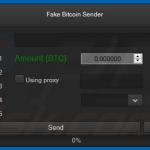
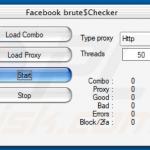
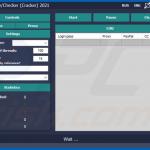
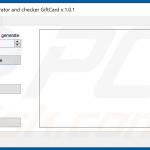
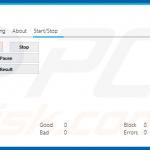
▼ Show Discussion